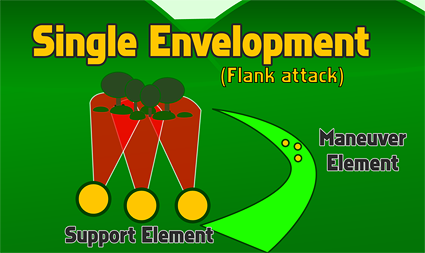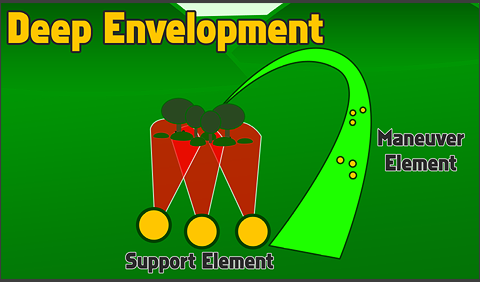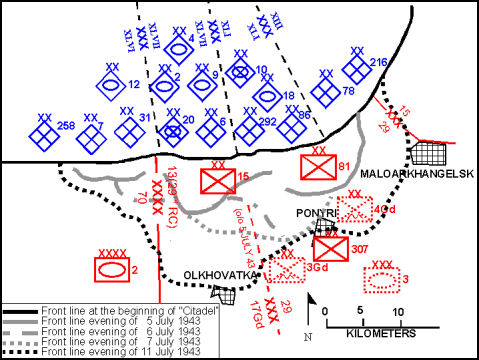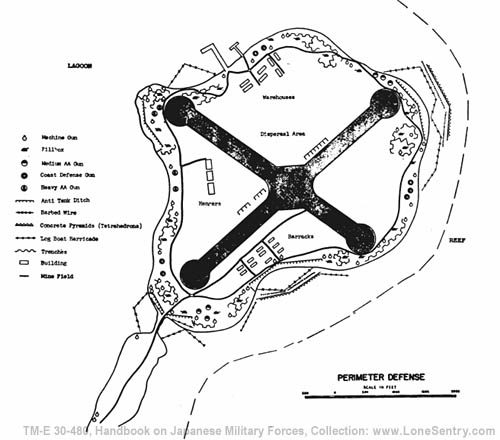Post by DaNiJeL on Nov 21, 2013 19:00:14 GMT
ATTACKING PRINCIPLES
There are 4 principles of attacking to take and hold ground.
Scouting
Recon is the first phase of any attack. To attack the enemy with as much detail as possible.
The goal of recon is to gather information about the enemy through the proper and skilled application of stealth and observation. Recon assets attempt to find out things like:
* Where the enemy is, along with what weapons they have, vehicle assets, their state of awareness, if they have patrols in the area...
*Where the enemy's defenses are, what they consist of, where the weakest points are.
*What the terrain is like around the enemy location, with regards to the friendly mission, locating good support by fire positions, assault lanes.
Isolation
The main point of isolating the enemy is that you want to ensure that the enemy is cut off from reinforcements or escape. Isolation should be done to the best degree possible, but due to various combat considerations it may not always be completely feasible to fully isolate an objective.
Isolating an objective can be accomplished in a number of ways. A great deal of it depends upon the forces available, enemy strength, and the terrain being fought in.
Preparation
Preparation is basically the act of blowing the enemy up to the best of your ability before ever starting the assault. Preparation can be done by artillery fire, close air support strikes, or crew-served weapons like the Mk-19. Mortar squads, if available, can be very effective in this role due to their proximity to the infantry they're supporting.
Suprise
There will be times when it will be more important to attack with surprise than to spend time preparing the objective with fire. Attacking suddenly, with violence and speed of action, and with surprise on your side.
ELEMENTS OF AN ATTACK
Attacks have 3 elements to them : the assault, support, and security elements.
Assault Element
The assault element is composed of the forces that will be closing with and destroying the enemy by fire and movement. They advance under the covering fire of the support element as far as they can as quickly as possible.
*The assault element attacks with speed and intensity and avoids getting stuck.
Support Element
The support element provides the support fire that covers the advance of the assault element.The key thing for the support element is that it must have the ability to provide a high radius of fire. This is often more dependent on the weapons that it employs, versus the number of personnel in it.
Security Element
A security element provides local security for forces during the assault. This typically means that they are focused on preventing exterior enemy forces from disrupting the conduct of the assault on an enemy position. The security element is the first line of observation for and defense against any attacks the enemy may attempt.
ATTACK TYPES
There are 4 types of attack
Frontal Attack
Frontal attacks are the most basic of attacks. A frontal attack is done against the weakest position that can be located on an enemy's front, taking advantage of all of the terrain, cover, and concealment that can be found.The success of a frontal attack depends entirely upon how effectively the enemy can be suppressed.
Single Envelopment
The single envelopment is where the base-of-fire element suppresses the enemy while the assault element moves around to a vulnerable flank and attacks. As with any element coordinated attack, the support element should be prepared to shift or cease fire to avoid inflicting friendly casualties.

Double Envelopment
A double envelopment attacks both flanks of the enemy at once while the enemy with the support element's fires. This can be a very effective form of attack, as long as the assault elements are aware of the risk of friendly fire.

Deep Envelopment
A deep envelopment is done when the situation and enemy disposition makes it possible for an element to pass by the enemy's flank security and strike them from behind. This sort of attack effectively splits the enemy's attention between two completely opposite directions.

DEFENDING PRINCIPLES
Security
A defense will fail completely if security is not established and maintained at all times. Security comes in the form of ensuring that the defensive positions can observe all around the defensive location and cover all possible approaches.
Positioning
Defenses require that the defending force takes measures to make themselves hard to kill. When given an area to defend, its needed to pick the positions to fight from that make them hard to kill. This is accomplished by taking advantage of every natural and artificial cover and concealment
Mutual support
Mutual support occurs when positions are able to fire in support of other nearby positions. The ultimate goal of mutual support is to make it impossible for the enemy to attack one position in isolation - instead, they will always find themselves engaged by a supporting position, forcing them to attempt to attack both positions at the same time.
DEFENSES TYPES
Linear Defense
Linear defenses are used when the terrain favors such a defense - for instance, if terrain makes it impossible for the enemy to bypass a given piece of terrain. A linear defense allows for friendly forces to mass firepower in one direction, with interlocking fields of fire and exceptional coverage. Linear defenses require that there are security elements posted on each flank, so that any attempts by the enemy to flank friendly positions will be seen and will be able to be reacted to.

Perimeter Defense
A perimeter defense can be established in any terrain. It is utilized when the enemy can be expected to attack from a number of directions at once, or when the enemy's attack direction is not known with reasonable certainty in advance.
Perimeter defenses take advantage of any natural cover in the area.

Reverse Slope Defense
A reverse slope defense can be a very effective form of defense if done properly. The basic principle of a reverse slope defense is that terrain is used to isolate the friendly forces from enemy fires and observation, forcing them to close with friendly forces and commit to a close-range fight where they lose many of the advantages they may have otherwise had in normal terrain.

There are 4 principles of attacking to take and hold ground.
Scouting
Recon is the first phase of any attack. To attack the enemy with as much detail as possible.
The goal of recon is to gather information about the enemy through the proper and skilled application of stealth and observation. Recon assets attempt to find out things like:
* Where the enemy is, along with what weapons they have, vehicle assets, their state of awareness, if they have patrols in the area...
*Where the enemy's defenses are, what they consist of, where the weakest points are.
*What the terrain is like around the enemy location, with regards to the friendly mission, locating good support by fire positions, assault lanes.
Isolation
The main point of isolating the enemy is that you want to ensure that the enemy is cut off from reinforcements or escape. Isolation should be done to the best degree possible, but due to various combat considerations it may not always be completely feasible to fully isolate an objective.
Isolating an objective can be accomplished in a number of ways. A great deal of it depends upon the forces available, enemy strength, and the terrain being fought in.
Preparation
Preparation is basically the act of blowing the enemy up to the best of your ability before ever starting the assault. Preparation can be done by artillery fire, close air support strikes, or crew-served weapons like the Mk-19. Mortar squads, if available, can be very effective in this role due to their proximity to the infantry they're supporting.
Suprise
There will be times when it will be more important to attack with surprise than to spend time preparing the objective with fire. Attacking suddenly, with violence and speed of action, and with surprise on your side.
ELEMENTS OF AN ATTACK
Attacks have 3 elements to them : the assault, support, and security elements.
Assault Element
The assault element is composed of the forces that will be closing with and destroying the enemy by fire and movement. They advance under the covering fire of the support element as far as they can as quickly as possible.
*The assault element attacks with speed and intensity and avoids getting stuck.
Support Element
The support element provides the support fire that covers the advance of the assault element.The key thing for the support element is that it must have the ability to provide a high radius of fire. This is often more dependent on the weapons that it employs, versus the number of personnel in it.
Security Element
A security element provides local security for forces during the assault. This typically means that they are focused on preventing exterior enemy forces from disrupting the conduct of the assault on an enemy position. The security element is the first line of observation for and defense against any attacks the enemy may attempt.
ATTACK TYPES
There are 4 types of attack
Frontal Attack
Frontal attacks are the most basic of attacks. A frontal attack is done against the weakest position that can be located on an enemy's front, taking advantage of all of the terrain, cover, and concealment that can be found.The success of a frontal attack depends entirely upon how effectively the enemy can be suppressed.
Single Envelopment
The single envelopment is where the base-of-fire element suppresses the enemy while the assault element moves around to a vulnerable flank and attacks. As with any element coordinated attack, the support element should be prepared to shift or cease fire to avoid inflicting friendly casualties.

Double Envelopment
A double envelopment attacks both flanks of the enemy at once while the enemy with the support element's fires. This can be a very effective form of attack, as long as the assault elements are aware of the risk of friendly fire.

Deep Envelopment
A deep envelopment is done when the situation and enemy disposition makes it possible for an element to pass by the enemy's flank security and strike them from behind. This sort of attack effectively splits the enemy's attention between two completely opposite directions.

DEFENDING PRINCIPLES
Security
A defense will fail completely if security is not established and maintained at all times. Security comes in the form of ensuring that the defensive positions can observe all around the defensive location and cover all possible approaches.
Positioning
Defenses require that the defending force takes measures to make themselves hard to kill. When given an area to defend, its needed to pick the positions to fight from that make them hard to kill. This is accomplished by taking advantage of every natural and artificial cover and concealment
Mutual support
Mutual support occurs when positions are able to fire in support of other nearby positions. The ultimate goal of mutual support is to make it impossible for the enemy to attack one position in isolation - instead, they will always find themselves engaged by a supporting position, forcing them to attempt to attack both positions at the same time.
DEFENSES TYPES
Linear Defense
Linear defenses are used when the terrain favors such a defense - for instance, if terrain makes it impossible for the enemy to bypass a given piece of terrain. A linear defense allows for friendly forces to mass firepower in one direction, with interlocking fields of fire and exceptional coverage. Linear defenses require that there are security elements posted on each flank, so that any attempts by the enemy to flank friendly positions will be seen and will be able to be reacted to.

Perimeter Defense
A perimeter defense can be established in any terrain. It is utilized when the enemy can be expected to attack from a number of directions at once, or when the enemy's attack direction is not known with reasonable certainty in advance.
Perimeter defenses take advantage of any natural cover in the area.

Reverse Slope Defense
A reverse slope defense can be a very effective form of defense if done properly. The basic principle of a reverse slope defense is that terrain is used to isolate the friendly forces from enemy fires and observation, forcing them to close with friendly forces and commit to a close-range fight where they lose many of the advantages they may have otherwise had in normal terrain.







